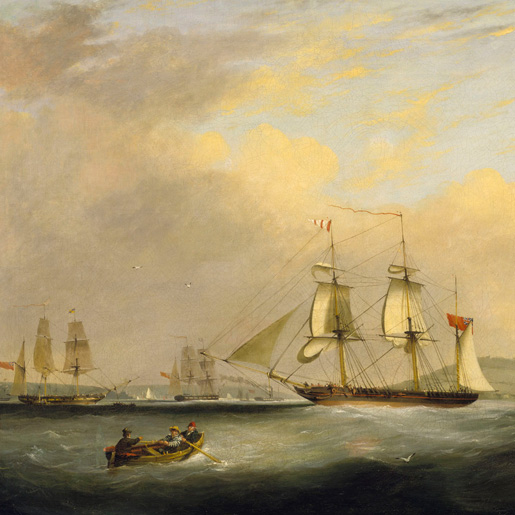

By Linda Batchelor
In 1776 Captain Edward Lawrance of the Packet Ship Anna Teresa left Falmouth for the West Indies. He kept a journal as a record of his voyage and to provide an account for his wife and family at home but he never returned, dying at sea.
A copy of the journal, donated by the Lawrance family, became part of the archives of the National Maritime Museum Cornwall and is now transcribed and available online on the Museum’s Maritime Views website. This Blog from the Bartlett Maritime Research Centre and Library provides some background information to accompany the journal.
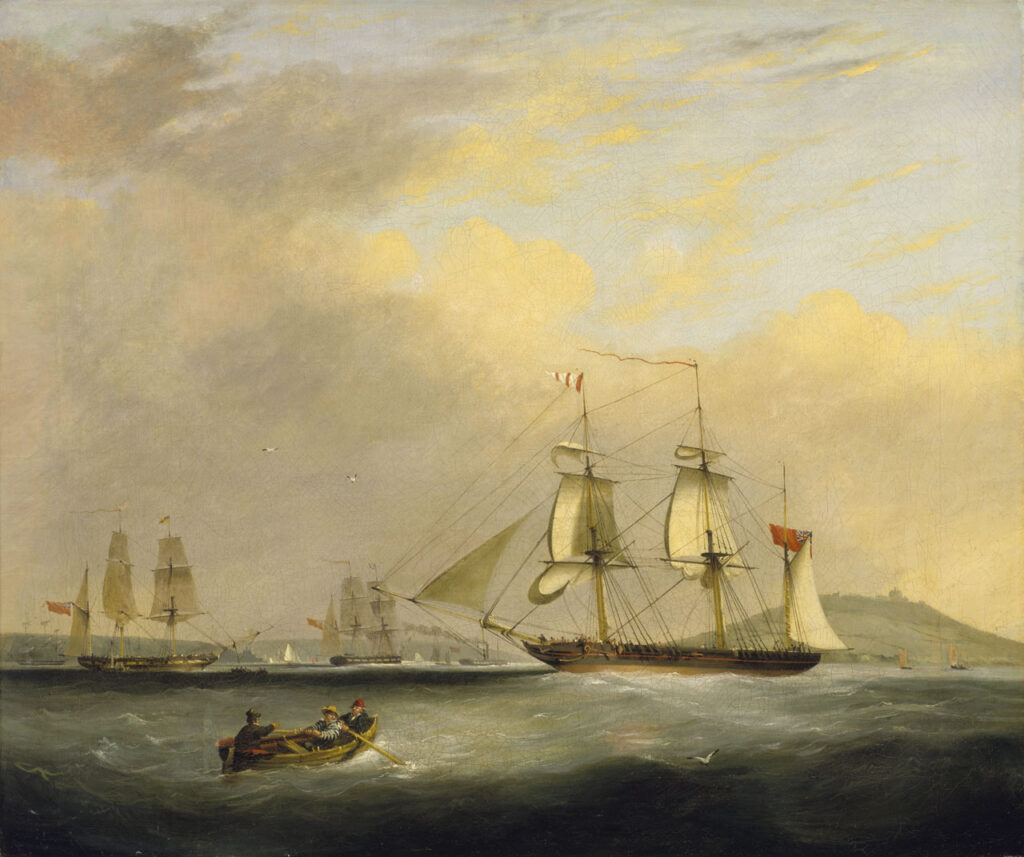
HMP Sheldrake entering Falmouth Harbour, Nicolas Matthew Candy, NMM Greenwich
“Sunday ye 9th June 1776 was the Day appointed by the Post Office for our sailing but Calms and contrary Winds prevented it, how very irksome to be detained, when we know that we must go.”
Captain Edward Lawrance of the packet ship Anna Teresa recorded this as the first entry in his journal as he was preparing to set sail from Falmouth via Madeira to the West Indies. Despite being ready to sail, the wind or lack of it, was hampering the ship’s departure. For Edward the delay was frustrating but also bittersweet as he was leaving his wife and young family for a voyage which would take many months.
He noted “ how pleasing is the Disappointment, when I reflect that a separation of five or six long months was so near at hand, which w.d part me from all I loved, what pleasure I say must one feel in once more spending an Evening with her I hold most dear and once more hear the prattling of my dear little ones, when the married are happy, how cruel the Separation, what must they feel, the parting is too, too much.”
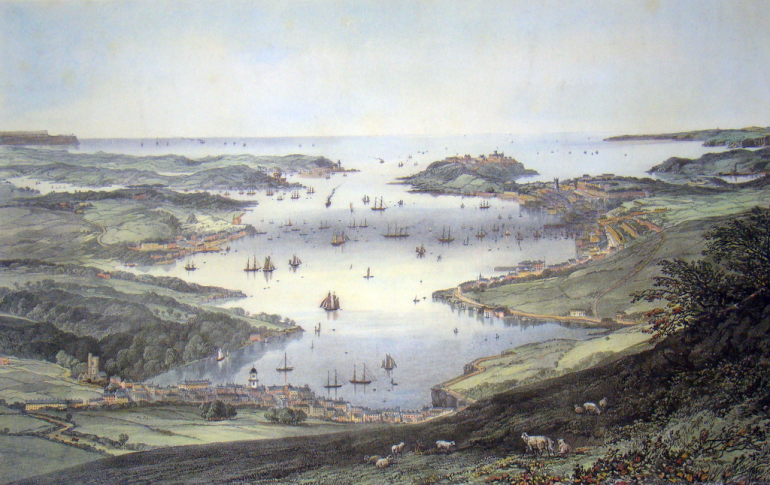
A View of Falmouth, Artist Unknown, Falmouth Art Gallery
Edward and the Anna Teresa finally left Falmouth in the afternoon of Saturday 15th June. He kept his journal from 9th June to 6th August not only as a record of the voyage but also as an extended letter to his wife Margaret, his ‘dearest Peggy’. He recounts his voyage via Madeira to the West Indies giving his impressions of the islands he visited the people he met and the business he conducted, sprinkled with details of the weather, the sailing conditions and the voyage in general. It was a way of keeping in touch with home and family but poignantly he was never to return and this was to be his last voyage. The journal ends abruptly on 6th August and four days later he died at sea off Martinique.
The Packet Service was a dominant influence in Falmouth and packet commanders were prominent members of the community, enjoying superior social standing and the honorific title of Captain. The majority of the vessels employed in the Falmouth Packet Service were privately owned, contracted to the Post Office to carry mails and official despatches to the European continent and to the Americas and the West Indies. By this time in his life Edward had acquired sufficient wealth or security to join the growing trend of commanders who could finance their own vessels. He was not only the Master and Commander but also the owner of the Anna Teresa.
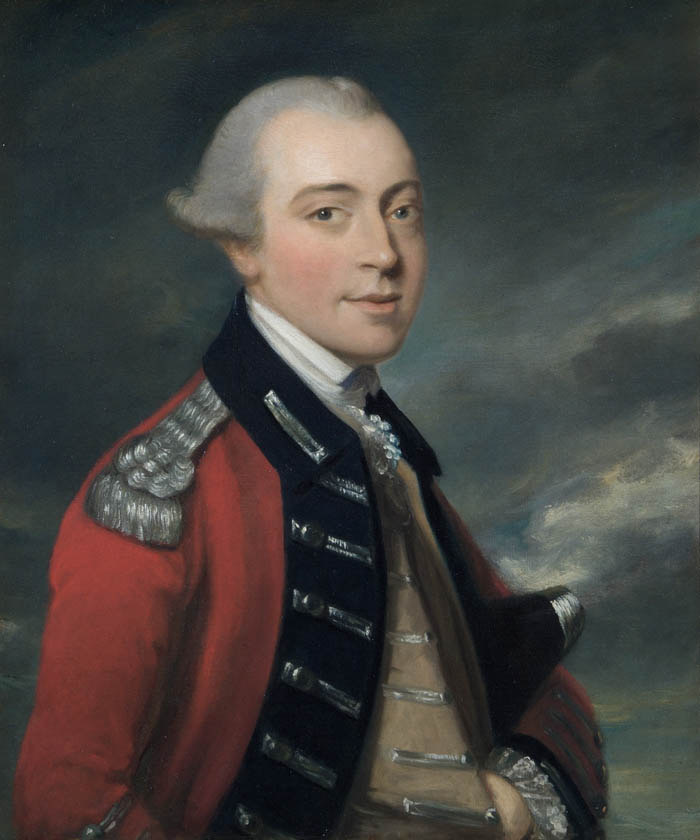
Portrait of a Packet Officer, Circle of Gainsborough, 1750, The Postal Museum
The rewards were considerable in terms of the money from the contracts earned for carrying the mails to the European Continent and to the Americas and the West Indies. There was also the money to be charged for passengers and the carriage of bullion together with other private dealings and packet crews were protected from impressment into the navy. However, as well as the usual perils of the sea there were the dangers of attack from pirates and privateers especially with the frequent and continuous periods of unrest and war and the ever-present threat of disease and death. Unfortunately for Edward his death was to be the conclusion to his sixth voyage to the West Indies and the Anna Teresa was brought home to Falmouth under her Sailing Master John Gaylard.
For the next few years the Anna Teresa continued to undertake the packet contracts to the West Indies without its owner and sailing under other commanders. In 1781 the vessel was lost when taken when under Captain Martin Crosby as a Prize in war by a frigate of the French Navy.
Captain Edward Lawrance was born in 1736 to Edward Lawrance and his wife Wilmot Daniell, the youngest child in a family of five elder sisters and a brother. The Lawrance family had been established in Feock near Truro since the seventeenth century. The family were merchants who had close relationships and involvement with the merchant community and with many of the commercial interests of Cornwall such as mining and shipping.
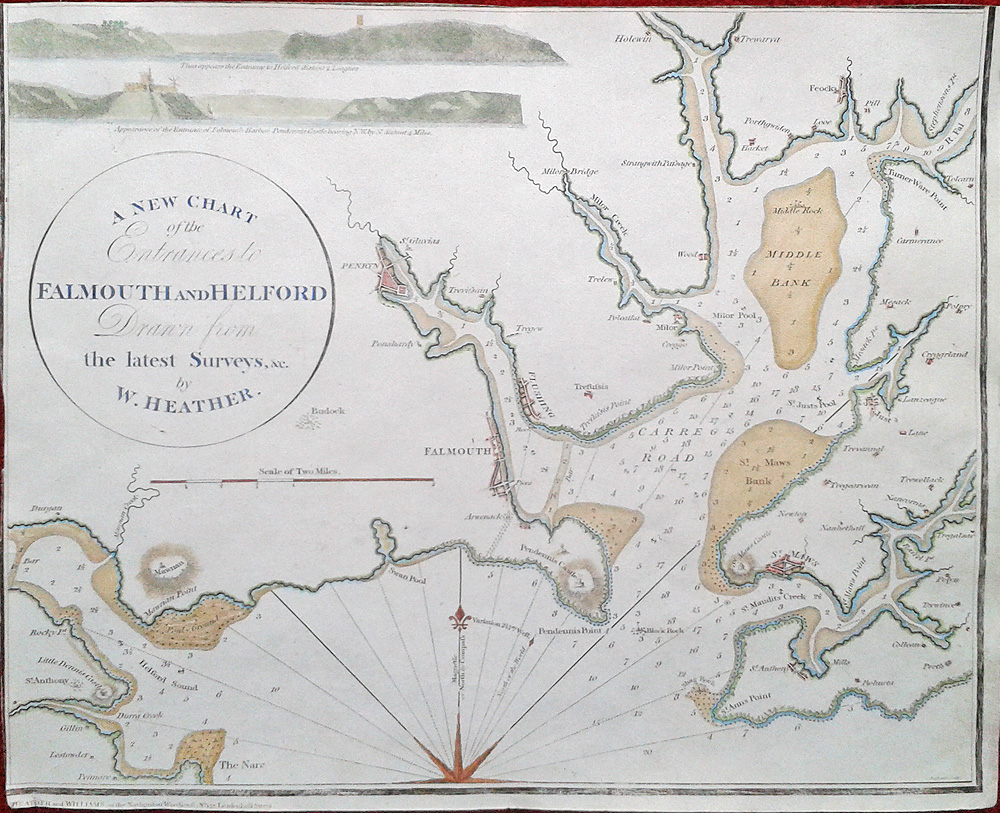
Chart of Falmouth and Helford, 1798, William Heather (1764-1812) Engraver & Publisher. Feock is shown on the upper right of the chart at the head of Carrick Roads above Middle Bank
During the first half of the 1700s Edward Lawrance senior, had leased the manor of Trevilla, which included Trelissick, from John Willyams. Trelissick is close to Feock a village on the Fal about five miles south of Truro and is set on its own peninsula with views over the Fal estuary down to Falmouth. In 1750 the manor was inherited by John Lawrance, the elder brother of Captain Edward Lawrance, who later employed Edmund Davy (the builder grandfather of Humphrey Davy) to transform the existing manor into a two-storey villa, the first Trelissick House, and began the development of the gardens.
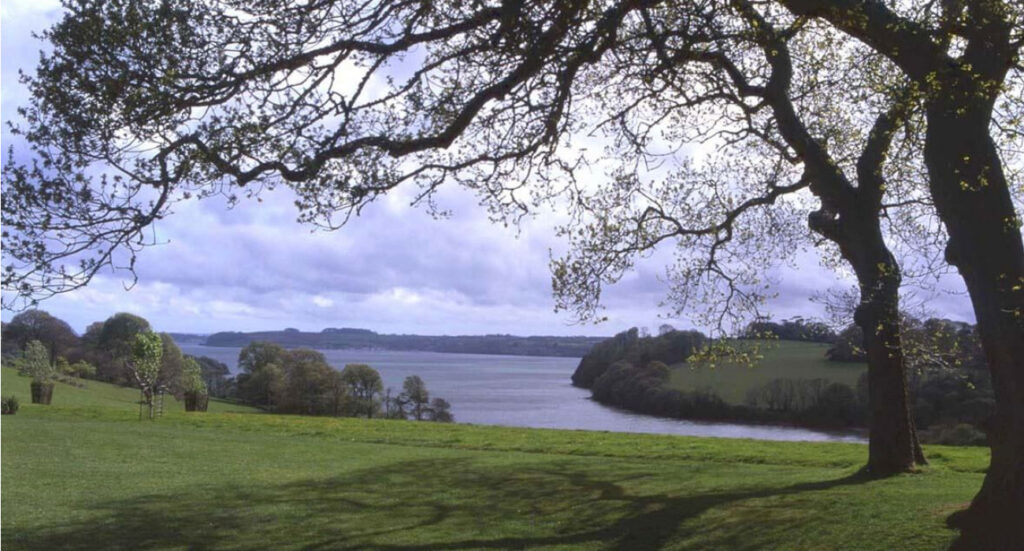
View from the grounds of Trelissick House looking down the Fal towards Falmouth
Edward meanwhile was taking on a maritime career in the nearby thriving port of Falmouth. By his late twenties he had acquired a position as a merchant captain, bringing with it the accompanying social standing and in his early thirties he had also become a packet commander and owner. Packet Captains were not directly employed but they and their ships were independently contracted to the Post Office. In May 1769 Edward was commissioned in command of the Anna Teresa on the packet routes to the Americas and West Indies.
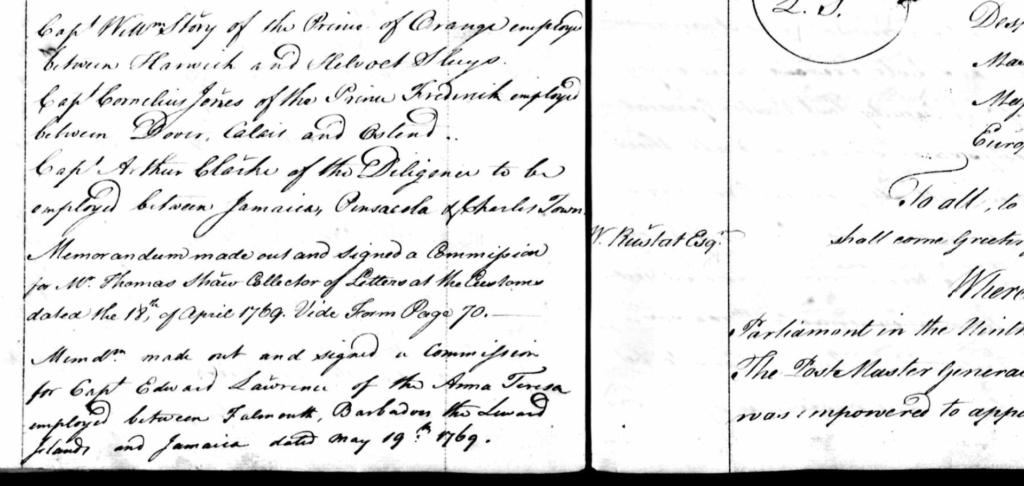
Post Office Commission for Edward Lawrance of the Anna Teresa, Falmouth to the West Indies. UK Postal Service Appointment Books, 1737-1969
The vessel named in the commission must have been the first so named in the packet service. Originally built in Philadelphia she was bought by Edward for use on the West Indies routes. Within a few years Edward had decided to replace her and in line with packet tradition would have been given two years to build a new ship during which time the older vessel would have continued in service. At this time many of the packet ships were ‘river’ built on the Thames but Captain Lawrance commissioned the work of the new build to Peter Simmonds at his yard at Little Falmouth which began setting a trend towards more locally built ships.
The launch of this new Anna Teresa in April 1773 was announced in the Stampford Mercury (29th April 1773) with the publication of a letter from a Gentleman of Falmouth to friends in London (dated 12th April).
Last Saturday was launched at Little Falmouth, near this place, in the presence of a numerous crowd of spectators, the Anna Teresa packet boat, built by Mr Peter Simmonds, for Edward Lawrance, Esq in the West India Service………. I assure you,she reflects the greatest credit to the builder………. I am therefore of the hopes we shall now bid adieu to your river built packets: and that for the future, our worthy Captains will stay at home to build their vessels.
In May the first Anna Teresa was successfully offered for sale and the new vessel left Falmouth on 12th July 1773 on her maiden voyage, returning in late November.
Falmouth had been a packet station since 1688 with established routes first to Corunna and then Lisbon. In the early 1700s Edmund Dummer had been contracted to operate the routes to the West Indies but his venture had resulted in bankruptcy and failure. It was not until 1740 that the routes had been re-established by the Post Office on a more commercially viable footing. These transatlantic voyages were the longest round voyages of the service often taking around five to six months and probably the hardest both mentally and physically on the seafarers. Whilst such voyages were a necessity in earning a living for all concerned and valuable to an owner such as Edward, in the first entry of his journal quoted earlier Edward writes with regrets of the pressures of such separation from home and family. Edward’s life at home reflected the dominance of the packet service in Falmouth and its neighbourhood.
As well as the direct employees of the Post Office such as the packet agents and staff there were the packet commanders and their crews and a whole range of support services. In direct support were the shipping agents, insurers and surveyors and the services supporting the marine industry from boat builders, shipwrights, equipment makers and chandlers. There were also the provisioners, innkeepers and hoteliers and all the local services that fed into the needs of the packet service.
Packet commanders lived in style in Falmouth, Flushing, Mylor and the surrounding areas and enjoyed a lively social life. Many of their relationships were closely formed amongst the local gentry, senior post holders and other packet commanders and their families. This was especially true when it came to marriage, with many packet officers marrying the daughters of other commanders or major figures in local society, as was the case with Edward. In 1770 Captain Edward Lawrance, Packet Commander of the Anna Teresa married Margaret Bell one of the daughters of George Bell, Packet Agent for Falmouth.
The Packet Service was part of the provision of the General Post Office under the Post Master General. This was an office held from 1691 to 1823 concurrently by two individuals. The office was politically sensitive and changed with the government so that the administration of the work of the Post Office including the Packet Service was the responsibility of the Secretary to the Post Master General and a Civil Service appointment based in London. Therefore, in order to provide efficient local running of the service the office of Packet Agent in Falmouth was created.
George Bell, originally from Durham, was the Falmouth Packet Agent from 1747 until 1776. He had come to Falmouth to work for the then Packet agent Stephen Banfield, appointed in 1723. In 1741 George had married Henrietta Banfield the daughter of Stephen and in 1747 had succeeded his father-in-law as the Packet Agent. In 1776 George himself was succeeded in the office by his son Stephen.
The family ties within the Packet Service were further emphasised by Stephen’s marriage to Frances Lovell, daughter of senior Packet Captain Robert Lovell and the marriages of three of his sisters to packet captains, one of whom was Margaret to Edward Lawrance in 1770.
The Bell’s home and the offices of the agency from 1764 was next to the old Post Office and became known as Bell’s Court. It was acquired from William Pye, Collector of Customs and was in the centre of Falmouth close to the waterfront and the Packet Quays. The 18th Century building is still there off Market Street. Now a bookshop and a pub, in its history it became a Working Men’s Club and then housed the Cornwall Maritime Museum, the forerunner of the NMMC. A plaque on the building records it as the home of George Bell the Agent for the Packets.
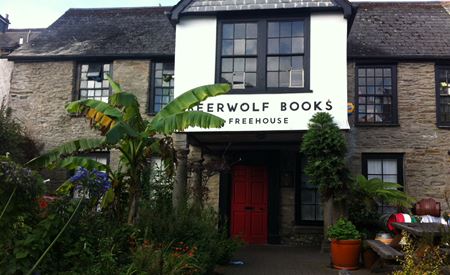
Bell’s Court, Falmouth, today. Built in the 17th Century and remodelled in the 18th Century it was occupied by George Bell and his family and also served as the Packet Office.
Edward and Margaret appeared to have had a happy marriage. Edward frequently described her as his ‘dearest Peggy’ and his contentment in his domestic life with her and his ‘dear little ones’ is obvious. He had been left without both of his own parents after 1741 and it is poignant that the happy life he and Margaret had together was to be short. Margaret was left with three young children on Edward’s death, Edward born in 1771, Elizabeth born in 1774 and George born in March 1776 before his father left Falmouth for the last time on the Anna Teresa. Margaret remained a widow until her death in 1812.
Margaret was also left to deal with the complexities of Edward’s estate including the ownership of the Anna Teresa and the property at Trelissick. His brother John, who had inherited Trelissick and had transformed the existing manor into a villa, did not marry and when he died in 1775 the estate passed to Edward who himself died within a year. The house at Trelissick was let to Frances Pender and some other parts of the estate such as King Harry Quay were let to Ralf Allen Daniell.
Ralf Allen was the son of Thomas ‘Guinea a Minute’ Daniell a wealthy merchant in Truro. Thomas had many merchantile interests and was a banker, a tin and copper smelter and a mine adventurer. He had been Chief Clerk to William Lemon, another successful merchant and on Lemon’s death had the resources to be able to acquire much of Lemon’s business interests. He built up a large and wealthy business empire and had married Elizabeth Elliott the niece and heir to the fortune of Ralph Allen of Bath who had introduced reforms to the Post Office. Their son was therefore named Ralph Allen Daniell and was part of this wealthy dynasty with both business and familial links with the Lawrances.
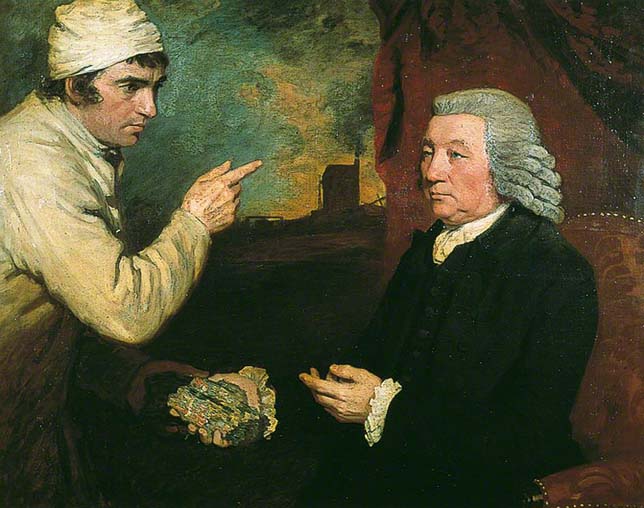
A Gentleman and a Miner John Opie (1761-1807) Royal Cornwall Museum (c) Royal Institution of Cornwall; Supplied by The Public Catalogue Foundation
After Edward Lawrance died Margaret and the family struggled with administering the estate and from 1790 this led to financial difficulties and debt. The creditors including Ralph Allen Daniell brought legal action against Margaret and the family, and in 1805 Trelissick was put up for sale to meet the debts. Ralph Allen Daniell growing further in wealth, especially in the mining industry, needed a sizeable house for his large family and Trelissick in an ideal location, with room for expansion and providing the prestige of a country estate was the answer. Ralph Allen paid £28,000 to acquire the house and the estate which then passed out of the ownership of the Lawrance family.
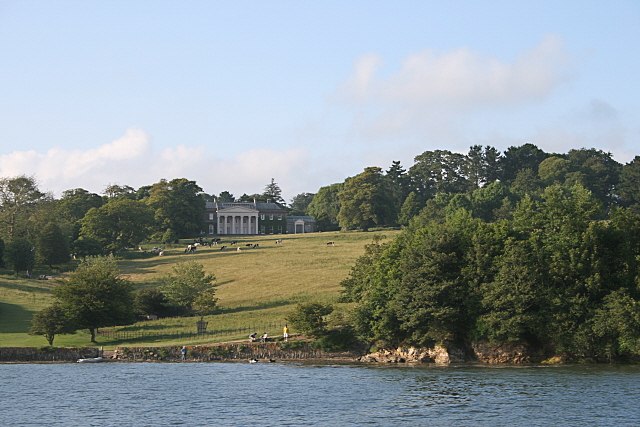
Trelissick House
Edward did however leave his family the legacy of a close connection with maritime enterprise and the Packet Service. Margaret raised their three children in Falmouth and those connections influenced their adult lives. Their son Edward Lawrance joined the Packet Service and became one of the senior packet captains and commander of HMP The Duke of Kent. Elizabeth Lawrence (1774 – 1825) married Thomas Murray in 1799 who was in command of the revenue cutter Ranger. Their brother George Bell Lawrance joined the Royal Navy and ultimately achieved the rank of Commander. It was George who had a copy of his father’s Journal and this was donated to the old Cornwall Maritime Museum in Bell’s Court and subsequently became part of the archive of the Bartlett Library in the National Maritime Museum Cornwall. Transcribed by Library Volunteer Gail Hawkins the Journal is now available online on NMMC’s Website.
The Journal is an insight into some of the territories served by the Packet Service and the conditions encountered when sailing those waters. It is also an insight into the dilemma of the sailor when the necessity of earning a living by undertaking time at sea conflicts with the pull of home and family. The opening of Edward’s Journal speaks eloquently, honestly and with a loving voice of that dilemma which still exists and gives the entry such an immediacy and a contemporary feel.
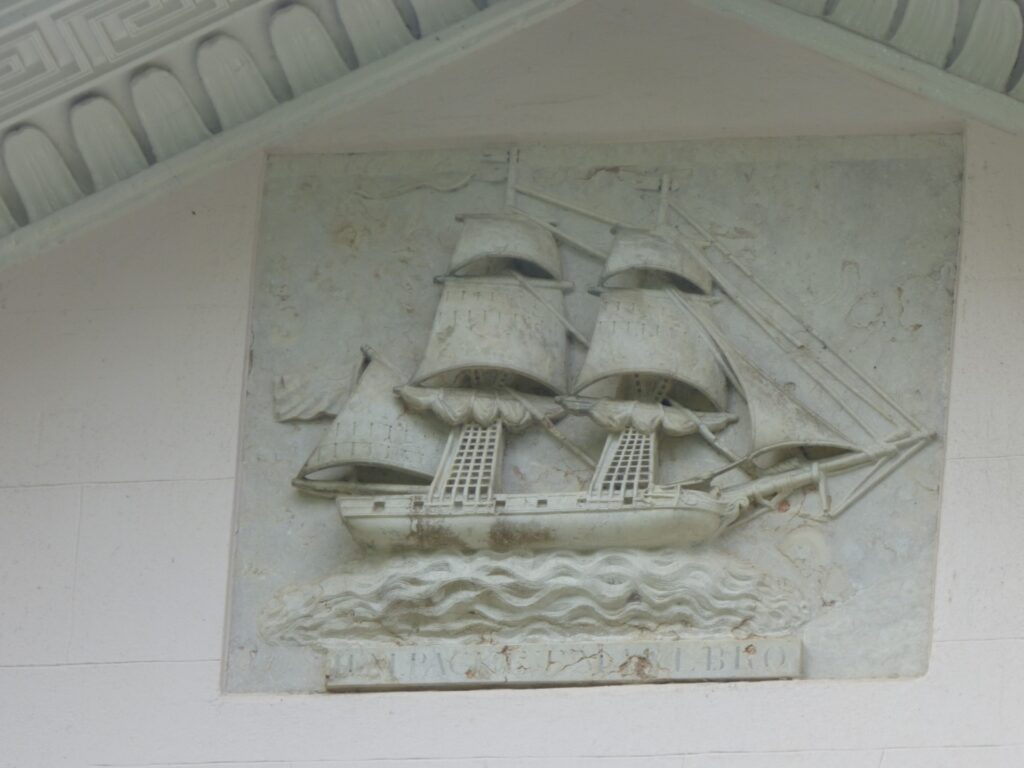
Relief of a Packet Ship on the House of a Falmouth Packet Captain. Photo by Lynne Vosper.
Edward Lawrance’s Journal Transcribed on the Maritime Views Website.
The Bartlett Blog is written and produced by the volunteers who staff The Bartlett Maritime Research Centre and Library of National Maritime Museum Cornwall. This blog post was written by Linda Batchelor, a Bartlett Library volunteer.
The Bartlett Maritime Research Centre & Library holds a Collection of over 20,000 volumes and offers access to one of the finest collections of maritime reference books, periodicals and archival material. The Bartlett Blog reflects the diversity of material available in The Bartlett Library.

National Maritime
Museum Cornwall Trust
Discovery Quay
Falmouth Cornwall
TR11 3QY
View Map
See our opening hours
Tel: +44(0)1326 313388
Email: enquiries@nmmc.co.uk